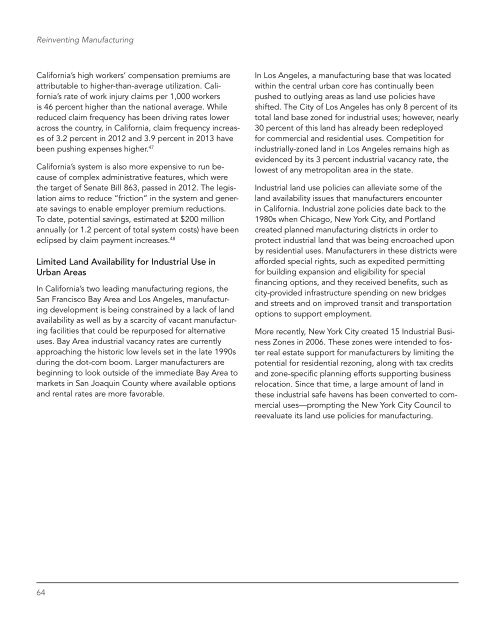Reinventing Manufacturing
eayWVRd
eayWVRd
You also want an ePaper? Increase the reach of your titles
YUMPU automatically turns print PDFs into web optimized ePapers that Google loves.
<strong>Reinventing</strong> <strong>Manufacturing</strong><br />
California’s high workers’ compensation premiums are<br />
attributable to higher-than-average utilization. California’s<br />
rate of work injury claims per 1,000 workers<br />
is 46 percent higher than the national average. While<br />
reduced claim frequency has been driving rates lower<br />
across the country, in California, claim frequency increases<br />
of 3.2 percent in 2012 and 3.9 percent in 2013 have<br />
been pushing expenses higher. 47<br />
California’s system is also more expensive to run because<br />
of complex administrative features, which were<br />
the target of Senate Bill 863, passed in 2012. The legislation<br />
aims to reduce “friction” in the system and generate<br />
savings to enable employer premium reductions.<br />
To date, potential savings, estimated at $200 million<br />
annually (or 1.2 percent of total system costs) have been<br />
eclipsed by claim payment increases. 48<br />
Limited Land Availability for Industrial Use in<br />
Urban Areas<br />
In California’s two leading manufacturing regions, the<br />
San Francisco Bay Area and Los Angeles, manufacturing<br />
development is being constrained by a lack of land<br />
availability as well as by a scarcity of vacant manufacturing<br />
facilities that could be repurposed for alternative<br />
uses. Bay Area industrial vacancy rates are currently<br />
approaching the historic low levels set in the late 1990s<br />
during the dot-com boom. Larger manufacturers are<br />
beginning to look outside of the immediate Bay Area to<br />
markets in San Joaquin County where available options<br />
and rental rates are more favorable.<br />
In Los Angeles, a manufacturing base that was located<br />
within the central urban core has continually been<br />
pushed to outlying areas as land use policies have<br />
shifted. The City of Los Angeles has only 8 percent of its<br />
total land base zoned for industrial uses; however, nearly<br />
30 percent of this land has already been redeployed<br />
for commercial and residential uses. Competition for<br />
industrially-zoned land in Los Angeles remains high as<br />
evidenced by its 3 percent industrial vacancy rate, the<br />
lowest of any metropolitan area in the state.<br />
Industrial land use policies can alleviate some of the<br />
land availability issues that manufacturers encounter<br />
in California. Industrial zone policies date back to the<br />
1980s when Chicago, New York City, and Portland<br />
created planned manufacturing districts in order to<br />
protect industrial land that was being encroached upon<br />
by residential uses. Manufacturers in these districts were<br />
afforded special rights, such as expedited permitting<br />
for building expansion and eligibility for special<br />
financing options, and they received benefits, such as<br />
city-provided infrastructure spending on new bridges<br />
and streets and on improved transit and transportation<br />
options to support employment.<br />
More recently, New York City created 15 Industrial Business<br />
Zones in 2006. These zones were intended to foster<br />
real estate support for manufacturers by limiting the<br />
potential for residential rezoning, along with tax credits<br />
and zone-specific planning efforts supporting business<br />
relocation. Since that time, a large amount of land in<br />
these industrial safe havens has been converted to commercial<br />
uses—prompting the New York City Council to<br />
reevaluate its land use policies for manufacturing.<br />
64


